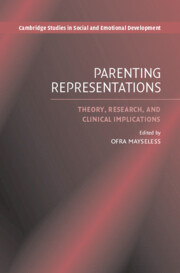Book contents
- Frontmatter
- Contents
- List of Illustrations
- List of Tables
- List of Appendixes
- List of Contributors
- Preface
- Acknowledgments
- Part One Theoretical Perspectives
- Part Two Research Applications
- Part Three Clinical Implications
- 9 Intergenerational Transmission of Dysregulated Maternal Caregiving: Mothers Describe Their Upbringing and Childrearing
- 10 Good Investments: Foster Parent Representations of Their Foster Children
- 11 Intergenerational Transmission of Experiences in Adolescence: The Challenges in Parenting Adolescents
- 12 Interplay of Relational Parent–Child Representations from a Psychoanalytic Perspective: An Analysis of Two Mother–Father–Child Triads
- 13 Why Do Inadequate Parents Do What They Do?
- Index
- Cambridge Studies in Social and Emotional Development
- References
12 - Interplay of Relational Parent–Child Representations from a Psychoanalytic Perspective: An Analysis of Two Mother–Father–Child Triads
from Part Three - Clinical Implications
Published online by Cambridge University Press: 10 July 2009
- Frontmatter
- Contents
- List of Illustrations
- List of Tables
- List of Appendixes
- List of Contributors
- Preface
- Acknowledgments
- Part One Theoretical Perspectives
- Part Two Research Applications
- Part Three Clinical Implications
- 9 Intergenerational Transmission of Dysregulated Maternal Caregiving: Mothers Describe Their Upbringing and Childrearing
- 10 Good Investments: Foster Parent Representations of Their Foster Children
- 11 Intergenerational Transmission of Experiences in Adolescence: The Challenges in Parenting Adolescents
- 12 Interplay of Relational Parent–Child Representations from a Psychoanalytic Perspective: An Analysis of Two Mother–Father–Child Triads
- 13 Why Do Inadequate Parents Do What They Do?
- Index
- Cambridge Studies in Social and Emotional Development
- References
Summary
Abstract
In this chapter a psychoanalytic perspective is applied to the examination of parents' representations of their relationships with their child, and to the interplay between these representations and the child's relational representations. A review of the psychoanalytic object relations and attachment perspectives on parent–child relational representations is followed by the illustration of the application of the Core Conflictual Relational Theme method (CCRT; Luborsky & Crits-Christoph, 1998) and the Working Model of the Child Interview (WMCI; Zeanah et al., 1986) to two mother–father–child triads. The CCRT identifies the content of relational themes in relationship narratives, while the WMCI assesses the parent's working model of the child and the relationship. Links between the parents' and child's relational themes and representation organization are presented in order to demonstrate the shared and unshared aspects of the inner worlds of parents and children, and the implications for clinical work with young children are discussed.
In this chapter, we apply a psychoanalytic perspective to parents' representations of their relationships with their child, and to the interplay between these representations and the child's relational representations. By applying the Core Conflictual Relational Theme method (CCRT: Luborsky & Crits-Christoph, 1998) and the Working Model of the Child Interview (WMCI: Zeanah, Benoit, & Barton, 1986) to the analysis of two mother–father–child triads, we will illustrate both the relational themes (content) and the cognitive aspects (organization and coherence) of the representations of the working model of the parent–child relationship (Gabarino, 1998).
- Type
- Chapter
- Information
- Parenting RepresentationsTheory, Research, and Clinical Implications, pp. 352 - 387Publisher: Cambridge University PressPrint publication year: 2006
References
- 2
- Cited by



